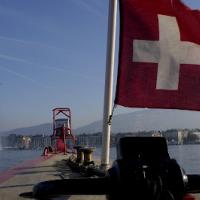The Netherlands and Australia Attribute the Downing of MH17 to Russia
Yesterday the international Joint Investigating Team (JIT) published its conclusion that the missile which destroyed the MH17 airliner over eastern Ukraine was fired by a Russian military unit, the 53rd Antiaircraft Missile Brigade. Here’s a summary of the evidence on which the conclusion was based:
Using satellite imagery and a photograph posted on social media, the JIT notes that Buk systems were located in a parking lot on the base of the 53rd brigade in Kursk. Using social-media videos, photographs published online, and geolocation techniques, the investigation concludes that six Buk systems were part of a larger military convoy that left the base on June 23, 2014.
Investigators then reconstructed the route, with the last available images of the convoy coming on June 25, 2014, about 25 kilometers from the Ukrainian border. The convoy includes a Buk missile launcher beginning with the number 3 — indicating it was from the 3rd battalion of the 53rd brigade. Bellingcat, using the same videos, previously assessed that the missile launcher in question was number 332. This is the system the JIT says was used to shoot down MH17.
…
The Buk launcher that shot down MH17 appeared in Ukraine in several photographs and videos on July 17 — the day of the tragedy — and the following day, according to investigators. Comparing images of that Buk system from the convoy originating from the Kursk base and those taken in Ukraine reveals seven “fingerprints” demonstrating that they show the same missile launcher, the JIT says. These identical “fingerprints” include a center-of-gravity marking, the same partially obscured number beginning with the numeral 3, and a wheel with no spokes in the same spot.
Today the Dutch and Australian governments formally attributed the missile strike to Russia, invoking its responsibility for an internationally wrongful act:
On the basis of the JIT’s conclusions, the Netherlands and Australia are now convinced that Russia is responsible for the deployment of the Buk installation that was used to down MH17. The government is now taking the next step by formally holding Russia accountable.’
State responsibility comes into play when states fail to uphold the provisions of international law. A state can then be held responsible for breaching one or more of those provisions. This is the legal avenue that the Netherlands and Australia have now chosen to pursue. Both countries hold Russia responsible for its part in the downing of flight MH17.
Holding a state responsible is a complex legal process, and there are several ways to do this. The Netherlands and Australia today asked Russia to enter into talks aimed at finding a solution that would do justice to the tremendous suffering and damage caused by the downing of MH17. A possible next step is to present the case to an international court or organisation for their judgment.
Obviously, regardless of the formal invocation of state responsibility, the Russian government is not going to suddenly change its story and admit that its armed forces shot down the MH17, whether acting ultra vires or not. When it comes to Russia’s domestic audience, the JIT’s findings will be easily discredited by the Kremlin’s propaganda machine – but we’ll see how they play out in any international litigation.


